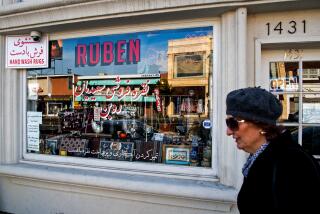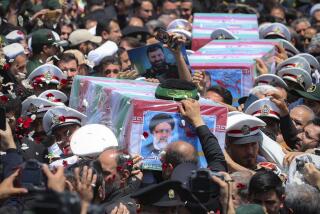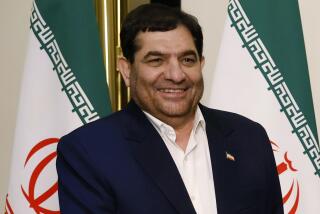Ayatollah Khomeini Dies at 86 : Fiery Leader Was in Failing Health Following Surgery
The Ayatollah Ruhollah Khomeini, the political priest who overthrew the world’s most powerful reigning monarch but never achieved his dream of either national unity or a worldwide Islamic revival, has died at the age of 86, Tehran Radio announced today.
The white-bearded imam died 12 days after surgery for intestinal bleeding, the report said. The terse announcement did not disclose the immediate cause of death or the exact time. The announcer choked with emotion as he said at 7 a.m. today (8:30 p.m. PDT Saturday): “Imam Khomeini has passed away.” U.S. intelligence has claimed that he battled cancer, but that was never confirmed by relatives or family physicians. Khomeini, however, had long suffered heart trouble; the problem dated to the 1950s. He was hospitalized in 1980--within a year of the revolution--for about five weeks.
In fact, the pressure and excitement of returning from exile on Feb. 1, 1979, led him to faint at the airport. When he came to, he muttered in a feeble voice, “Water.”
Since Khomeini fired his heir-apparent, the Ayatollah Hussein Ali Montazeri, in the spring, Iran’s succession has been in question--leading Iran’s specialists to conclude that the country is in many ways more vulnerable in terms of future leadership than at any point since the revolution.
In August, Iran faces presidential elections. One of the few things it shares with the United States is a two-term limitation on the presidency. Parliament Speaker Hashemi Rafsanjani, long the second most powerful figure in Iran, has been a leading candidate, but his religious credentials are widely considered insufficient to alone inherit the mantle of “supreme jurisprudent”--the post Khomeini held for 10 years.
The situation is complicated by current deliberations over constitutional reforms, which have not been finalized and which officially needed Khomeini’s approval. Without an obvious heir-apparent and without final agreement on the reforms, the theocracy faces a highly volatile period.
In many ways, Khomeini could not have died at a worse time. The religious leaders may coalesce in the short term, but over the long haul, the power struggle that has divided the regime since 1979--and that Khomeini managed to avoid by playing off pragmatists and hard-liners--must be solved.
Highly Recognizable
His menacing black brows and piercing eyes were recognized by most people of the world, yet he was truly known only by a handful of relatives and disciples who followed him for decades from the seminary to the corridors of power.
His beliefs and ideas on almost every subject from the most mundane acts of daily life to the most profound philosophical, political and theological questions flowed prodigiously from his pen and pulpit for more than 60 years, yet relatively few of his lay followers even pretended to understand them.
Khomeini led a popular revolution that drew nearly unanimous support from the Iranian people to end the 37-year rule of the late Shah Mohammed Reza Pahlavi as well as 2,500 years of monarchy. Yet he almost placidly let his victory slip into civil strife, bloodshed and political morass. His tall, slender figure, distinguished by a dark flowing cape and carefully wrapped black turban, cast a longer shadow across the oil-rich Middle East region and the world of Islam than all but a few historic figures.
To Americans, most of the achievements of the priest who shook the world were dismaying paradoxes, and the imam (representative of God on Earth) remained an enigma to the end. His public and private personalities were rooted in the mystic conviction that he was God’s appointed spokesman. He saw worldly problems in the strictly fundamentalist religious terms of the Shiite branch of Islam and firmly believed that their solutions were clearly charted 13 centuries ago in the Koran.
Although he confessed to human frailties--”I cry, I laugh, I suffer”--he never showed emotion as he ordered waves of executions, cold-bloodedly abandoned his closest associates and approved the seizure of American diplomats as hostages.
The high point of the revolutionary ayatollah’s reign was his triumphant return from 14 years in exile, most of it in Iraq and then France, to Tehran on Feb. 1, 1979, when the shah’s army was still intact and the shah’s last prime minister, Shahpour Bakhtiar, clung tenuously to power. Millions poured into the streets to welcome the austere religious figure whose portrait and tape-recorded messages had become rallying points of the revolution, and the shah’s army and government crumbled 10 days later.
The low points, from an international perspective, were the seizure of the U.S. Embassy by militant students Nov. 4, 1979, and the 14-month ordeal of the American hostages, which Khomeini used to revive the zealotry of Iranians at a time when his revolution appeared to be running out of steam.
Although he denied ordering the embassy takeover, Khomeini quickly seized upon it to vent his rage against the United States, which he equated in his hatred with the shah. He tried to use the hostages as bargaining chips in exchange for the shah, who was undergoing medical treatment in the United States. He called America “the great Satan from which all the little Satans of this world spring.”
The old man’s righteous anger was the mark of his rule to the world outside Iran. Throughout the 1980s, his determination to bring down Iraqi President Saddam Hussein, a member of the Sunni sect of Islam, fed a crushing, monumental war between their countries that ended only when the near-collapse of the Iranian army forced Khomeini to “swallow poison” and accept a truce.
Yet while he railed against America, Israel and a host of outside powers, the complexity of his causes time and again confounded outsiders. Locked in the war with Iraq, Speaker of Parliament Rafsanjani in 1985 entered into negotiations, reportedly with Khomeini’s knowledge, to buy American weapons, loosing the Iran-Contra scandal.
And when the war was over, as Khomeini appeared crestfallen and ever more reclusive, his government adrift in political squabbles over how to get the country back on its feet, the ayatollah sprung another series of shocks. Stoking the fires of zealotry, and sending a message against political moderation, he plucked out an issue simmering in the Muslim communities of Pakistan and India, a novel entitled “The Satanic Verses.”
Khomeini declared that its author, Salman Rushdie--a British citizen born of Muslim parents in India--had blasphemed the Prophet Mohammed and should he hunted down and killed as an apostate. European governments that had considered postwar aid recoiled, recalling their ambassadors.
Then, in case Iranian politicians hadn’t gotten the message that he wanted no break from fundamentalist Islamic values, Khomeini forced the resignation of the man chosen, by his own constitution, to succeed him, Ayatollah Montazeri, who had the temerity to speak out against judicial excesses in Iran.
By this time older and more infirm, the ayatollah was otherwise much the same man disinclined to raise a finger to free the American Embassy hostages in 1979, an unbending leader of righteous pronouncements who appeared unconcerned about the consequences.
By the time President Jimmy Carter had negotiated the release of the captive diplomats on Jan. 20, 1981, the day he turned over the presidency to Ronald Reagan, Iran had suffered more from the long ordeal than its victims.
The nation was politically divided into numerous factions, including rebellious, autonomy-seeking ethnic minorities in Azerbaijan, Kurdistan, Arab Khuzistan and Baluchistan, and important segments of the population, including the middle class and the merchants of the bazaar, were turning against Khomeini. Even more important to the 20th Century’s only theocracy were the growing signs of divisions within the clergy itself.
Iran’s economy was in shambles, made worse by the cost of the grinding war that began when Iraq, seeking to topple Khomeini, invaded southwestern Iran on Sept. 22, 1980. By mid-1981, a third of the nation’s work force of 12 million people was unemployed, inflation was at 60% and many commercial and industrial operations were crippled by the flight of more than a million educated Iranians after the revolution.
Politically, the war had widened a chasm between Khomeini’s zealously loyal mullahs (clergymen), who controlled large segments of the uneducated masses, and the more sophisticated and largely Western-educated lay leadership that helped put him in power and had attempted in vain to shape an orderly national government.
In 1981, the mullah-dominated Islamic Republican Party hounded President Abolhassan Bani-Sadr out of office and into exile, even though the French-trained economist had long been one of Khomeini’s closest and most loyal advisers.
A few weeks later a powerful bomb at party headquarters in Tehran killed 72 leaders of the party.
Characteristically, Khomeini appeared to be unmoved by the shock waves after the president’s ouster and the mass assassination. He heartily approved of the wave of summary executions of hundred of alleged dissidents that followed.
The personal life of the inscrutable religious revolutionary was as enigmatic as his public record. Khomeini dismissed questions about his background and family life, leading one frustrated writer to conclude that “he does not seem to know or care very much about his antecedents.”
Khomeini was born in the small town of Khomein, 180 miles south of Tehran, in 1902. Like many mullahs, he eventually took a surname based on his birthplace. He was the youngest of the six children of Mostafa Moussavi, a cleric and a farmer.
When Khomeini was only a few months old, Moussavi was killed in a quarrel. A popular version is that he died a martyr at the hands of a cruel governor over a matter of religious principle. Another version says he was killed while arguing over a debt to a neighbor.
Both Khomeini and his older brother, who survives him, attended Koranic lower schools, devoted largely to memorizing the Koran, believed by Muslims to be God’s word dictated to the prophet by Gabriel, and to the study of the sayings and traditions of Mohammed. The brothers, both excellent students, went on to study under a leading Shiite scholar of the time, Abdul Karim Haeri, who founded the Faizieh Theological School in the holy Shiite city of Qom in 1920.
At Faizieh, Khomeini’s education was broadened to include the ancient Greek philosophers, although it was not comprehensive in the modern sense and he remained ignorant of many aspects of modern life.
It was apparently from Plato’s “Republic” that Khomeini adopted the idea of the philosopher-king that he aspired to become, a wise dictator firmly and, when necessary, ruthlessly directing the lives of his people according to the moral dictate of God as interpreted by the leading Shiite clergyman.
Against this background, 60 years later, a draft constitution of the Islamic Republic was rewritten to include the position of Velayet Faghih--supreme religious guide--for himself.
“Pious, dedicated and sincere,” the constitutional Faghih holds ultimate power over government and armed forces and can control the courts as well. Khomeini held the office until his death.
Khomeini’s theory of government included what he called his “fundamental three points”--independence, liberty and resistance to foreign domination. But his political philosophy was so intermixed with fundamentalist religious exposition in his considerable writings that a clear policy approach to governing a nation in the modern world was hard to discern.
His writing covered even minute examinations of the correct Islamic way to perform such mundane acts as washing oneself and swatting mosquitoes.
From what little is known about his relatives, they appear to be almost as pious as he was. Although he often reiterated his belief in Islamic bigamy, including the special Shiite sanction of “temporary” wives when the four allowed by Islam are not sufficient, he had only one wife, Batoul, the daughter of an ayatollah. They married when Khomeini was in his late 20s and she was barely a teen-ager. She is still living.
“A woman needs a man,” he once said to Italian journalist Oriana Fallaci, “so what can we do since there are more women than men in the world? Would you prefer that the excess number of women become whores?”
He fathered six children, of whom four survive him.
At the time of Khomeini’s death, his second son, a mullah named Ahmed Khomeini, was among his closest personal and political advisers.
Although Khomeini appeared to enjoy a warm, enduring relationship with his family, members of his political entourage found him difficult to deal with and, in some cases, treacherous.
His first prime minister, Mehdi Bazargan, a distinguished Muslim liberal who devoted his life to fitting Islamic concepts into a modern society and was four times jailed by the shah, complained that Khomeini often assured him of support but then reneged.
In the face of Bazargan’s threats to resign, Khomeini repeatedly promised to stop interfering with government attempts to restore order in the staggering post-revolutionary country. But in every instance the imam did a turnabout, bypassing Bazargan’s hapless Cabinet and ruling by decree to establish uncontrollable revolutionary courts and reinforce strict observance of Muslim religious laws, including a ban on alcohol and capital punishment for homosexuality, prostitution and adultery.
When Khomeini enthusiastically embraced the seizure of the U.S. Embassy by militant Muslim students, Bazargan resigned and his government, including other former intimates of Khomeini, was disbanded.
It may have been his political boldness rather than his theological standing that eventually brought Khomeini’s fellow mullahs to call him ayatollah, or mark of God, a title with no formal qualifications other than the admiration of one’s peers but one that elevates a Shiite cleric to the top rank of religious leadership.
In the late 1950s and early ‘60s, Khomeini assumed a leading role among Iran’s 60 or so ayatollahs by aiming such bitter diatribes at the shah that the angry monarch eventually retaliated. In 1962, the shah’s troops invaded Khomeini’s Faizieh school and killed more than a dozen students, setting off riots in Tehran and Qom that were said to have cost up to a thousand lives.
“My heart is ready for the bayonet of your troops--I shall never keep quiet,” Khomeini protested in a letter to the shah’s prime minister. As a result he was placed under house arrest. But upon his release he again denounced the Pahlavis.
In 1963, he added what proved to be his most popular theme--anti-Americanism--to the campaign against the shah. A status-of-forces bill giving U.S. service personnel in Iran immunity from local law and courts was pending, and Khomeini’s outspoken opposition to it earned him a second arrest.
After several months in prison, he was exiled by the shah to Turkey on Nov. 4, 1964--a date that would be marked 15 years later with the seizure of the U.S. Embassy in Tehran. Unhappy in Turkey, he moved later in the year to Najaf, Iraq, one of Shiite Islam’s holiest cities. There Khomeini began to amplify on his vision of an Islamic republic responsive to the masses but dominated and guided by clergymen under the inflexible dictate of Islamic law.
Ironically, a Western invention, the cassette tape recorder, became in effect his highway back to Iran. Khomeini began recording his bitterly eloquent preachments against the shah, calling for an Islamic resurgence in troubled Iran. The tapes were sent to Iran, duplicated and played in mosques throughout the country.
By 1978 the almost unending ribbon of taped diatribes had so inflamed the shah that he asked Iraq to expel Khomeini. Exiled again, the aged ayatollah went to France. There Khomeini assembled his exiled followers from Europe and the United States. He was introduced to the world press, and for the first time his daily pronouncements could be transmitted instantly to Tehran.
Although there were other, more moderate opposition groups in Iran, Khomeini’s simple themes of Islamic virtue and his slogan, “death to the shah,” united the already disaffected masses of the country under his banner and swept the less extremist leaders aside. On Jan. 16, 1979, after months of bloody rioting throughout Iran, the shah left Iran on a “vacation” that never ended. He died in Cairo, of cancer, in July, 1980. Khomeini returned to Iran in triumph 16 days after the shah’s departure to receive the adulation of millions.
Times Caribbean correspondent Schanche was formerly based in Cairo, where he covered much of the Middle East. Times staff writer Robin Wright, in Washington, Nick B. Williams Jr., The Times’ Bureau chief in Nicosia, Cyprus, and Charles P. Wallace, a former Nicosia Bureau chief now stationed in Bangkok, Thailand, also contributed to this story.
More to Read
Sign up for Essential California
The most important California stories and recommendations in your inbox every morning.
You may occasionally receive promotional content from the Los Angeles Times.










